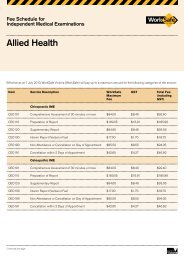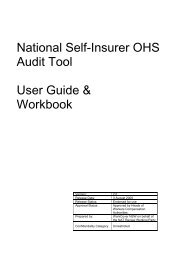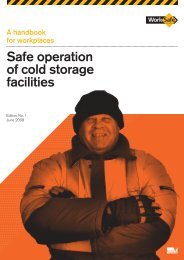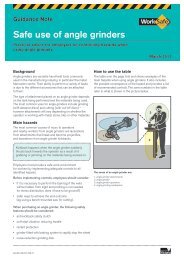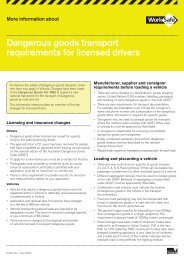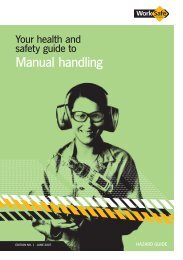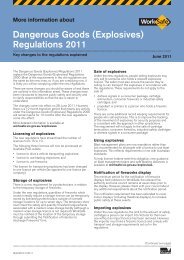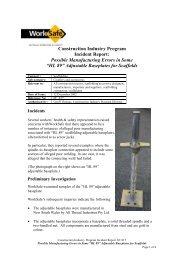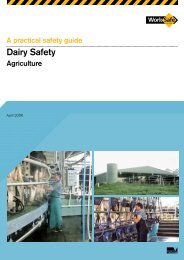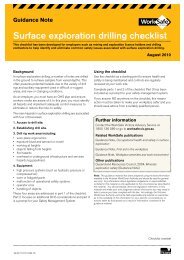Machinery and Equipment Safety - An Introduction - WorkSafe Victoria
Machinery and Equipment Safety - An Introduction - WorkSafe Victoria
Machinery and Equipment Safety - An Introduction - WorkSafe Victoria
Create successful ePaper yourself
Turn your PDF publications into a flip-book with our unique Google optimized e-Paper software.
RISK CONTROL OF MACHINERY<br />
AND EQUIPMENT HAZARDS<br />
Other mechanical hazard risk control options<br />
A two-h<strong>and</strong>ed control option may be suitable<br />
to ensure that a machine cannot operate until<br />
both h<strong>and</strong>s of the operator are clear of the<br />
hazard area.<br />
A light curtain used to disable the hazardous<br />
mechanism of a machine must resist failure<br />
<strong>and</strong> fault.<br />
Simultaneous two-h<strong>and</strong>ed operation<br />
Where a machine has only one operator, the use of simultaneous two-h<strong>and</strong>ed<br />
operation buttons can serve as a risk control. This ensures that operation of the<br />
hazardous mechanism cannot occur until both h<strong>and</strong>s are clear of the danger area.<br />
The two buttons must be pushed at the same time <strong>and</strong> are located at a distance<br />
from each other that prevents simultaneous operation by one h<strong>and</strong>.<br />
The operation should be designed so that if either or both of the buttons are<br />
released, the hazardous action of the machine or equipment cannot be reached,<br />
or if it can be reached, the mechanism returns to a safe state.<br />
Presence sensing systems<br />
If physical guards are not reasonably practicable, then a presence sensing system<br />
can be used as a control to reduce risk. Presence sensing systems can be used<br />
where people enter areas shared by moving production equipment.<br />
Presence sensing systems are capable of providing a high degree of flexibility<br />
with regard to access.<br />
Presence sensing systems detect when a person is in the identified danger area,<br />
<strong>and</strong> stops or reduces the power or speed of the mechanism at the time of entry<br />
to provide for safe access.<br />
Presence sensing systems can rely on foot pressure pads, infra-red sensing, light<br />
beams or laser scanning. The most appropriate type of sensing device will depend<br />
on the operating environment <strong>and</strong> access requirements.<br />
Australian St<strong>and</strong>ard AS 4024.2 provides guidance on design specification, ratings<br />
on integrity <strong>and</strong> reaction times. Manufacturers’ specifications for installation <strong>and</strong><br />
maintenance must also be observed.<br />
Specialist assistance may be required by experienced professionals to ensure<br />
correct selection <strong>and</strong> installation of presence sensing systems. Companies<br />
who manufacture or supply these systems also provide technical support<br />
<strong>and</strong> installation assistance.<br />
WORKSAFE VICTORIA / MACHINERY AND EQUIPMENT SAFETY – AN INTRODUCTION 11




